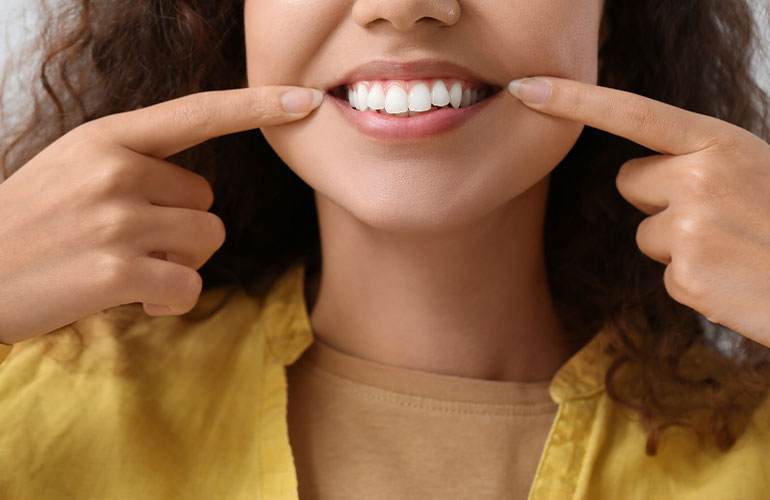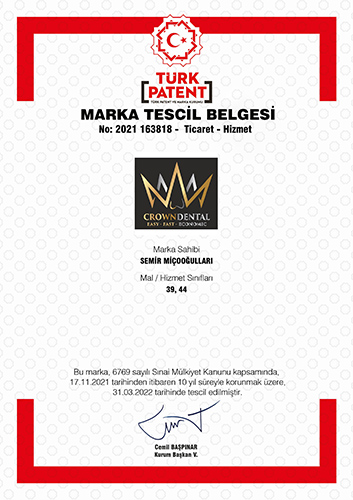Teeth whitening and coating have an important place in aesthetic dentistry. These treatments, which give people a more aesthetic smile, are applied by the professional physicians of our clinic with a 100% success rate.
How Is Teeth Whitening Made?
The darkening of the tooth color is removed with this method and the teeth regain their old natural appearance. The whitening process performed under the control of a specialist dentist never harms the teeth and fillings.
Although there are various mixtures, whitening pens and pastes used for teeth whitening, their effect is limited. The best and permanent results can be achieved with teeth whitening.
The preferred methods for this are as follows:
Home Type Teeth Whitening
- An oral impression is taken and a transparent, thin, soft plate is prepared accordingly.
- A whitening gel in the form of a syringe is squeezed into it.
- The patient is told to apply it for 4-6 hours every day for 10-15 days.
- After 1 week of use, the teeth will begin to whiten.
Office Type Teeth Whitening
This method of treatment is carried out with highly concentrated bleaching agents. Or a laser-assisted treatment can also be applied. It is done in 2-3 sessions.
Single Teeth Whitening
Teeth that undergo root canal treatment may also darken over time. During the operation, the filling in the discolored tooth is removed. It is closed with temporary filling by applying whitening gel.
Several sessions are repeated until the tooth reaches the desired color. Then permanent filling is done and the treatment is completed.
Types of Dental Veneers
Veneer treatment can also be applied to give the teeth with advanced discoloration a beautiful appearance. This method can be used for smile design in patients who want permanent whiteness and are not satisfied with the color of their teeth.
Coating may be needed in patients who have undergone root canal treatment and whose results cannot be achieved with bleaching.
The veneer process is also used in the teeth that are discolored due to antibiotics, in the correction of the teeth that are slightly drooping, and in the crookedness that requires orthodontic treatment.
If the patient’s tooth is irreparably decayed, this is compensated with the help of tooth veneer.
Porcelain Dental Veneers
These structures, also known as porcelain lamina , are adhered to the anterior surface of the tooth with a bonding system. These porcelain leaf teeth, which have a very thin form, are resistant to breakage. It is resistant to discoloration caused by products such as cigarettes, tea and coffee . It gives natural shine and whiteness to the teeth, they do not recolor.
During the application, excessive abrasion is not made from the tooth surface. Therefore, it is a harmless and conservative procedure. The thickness of porcelain laminates is not more than the thickness of a lens.
Thanks to the porcelain lamina, it is possible to close the gaps between the teeth, extend their length and reshape them. This treatment, which heals badly formed (cracked, broken, etc.) teeth, is applied in a few sessions. In the first session, the teeth are measured. The models required for the rehearsal are prepared and placed in the patient’s mouth to ensure that they are suitable.
Impression is performed by removing very little enamel tissue from the front surface of the tooth. Porcelain laminates of appropriate color and size are designed and adhered according to this measure.
Full Ceramic Dental Veneer
These veneers, which are produced in a very similar way to natural teeth, are also called ‘ empress veneers’ or ‘ full porcelain veneers’. These coatings, which have a crystalline structure, have high light transmittance.
This treatment, which provides a perfect smile by arranging the harmony of the teeth with each other, also eliminates the deformities of the teeth.
It is suitable for cases where coating on a single tooth is required. Ceramic coating is not preferred in patients with missing teeth and needing bridge treatment. If a metal abutment is used on the implant , ceramic coating is not recommended. Otherwise, a color problem will occur.
Zirconium Dental Veneers
This type of coating is advantageous as it does not cause cold/hot sensitivity. It is often preferred in anterior teeth.
Metal Supported Dental Veneers
Sometimes metal alloy porcelains are also used for coating. These are more affordable in terms of cost. However, they are distinguished by their dark color and do not present a natural appearance. It is generally used on posterior teeth.
Can the coated teeth be whitened?
Composite fillings, porcelain crowns, veneers cannot be removed from the mouth. For this reason, they cannot be bleached. Gels used in home or office whitening processes have an effect on natural teeth. In order to achieve the desired whiteness, it is necessary to renew the old tooth coatings.





